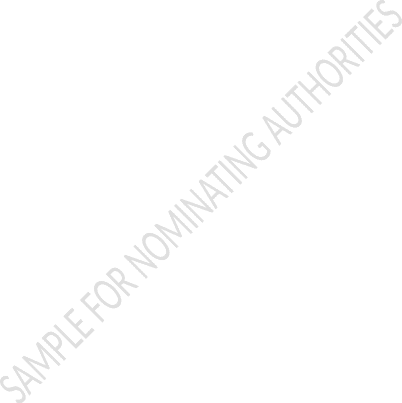Sample Application - IHE
sample-application-IHEs -2015.doc
U.S. Department of Education Green Ribbon Schools Nominee Presentation Form
Sample Application - IHE
OMB: 1860-0509

Note
to Nominating Authorities: This sample application is provided to
assist you, but is not required. You are encouraged adapt to your
jurisdiction’s needs in order to document how your nominees
are high performing in every Pillar and Element. 

Note to Nominating Authorities: This sample application is provided to assist you, but is not required. You are encouraged to adapt all of it to your jurisdiction’s needs. The overall aim is use a format that shows how your nominees’ are high performing in every Pillar and Element within the allowable page limit. How you achieve that is up to you. These are merely some suggestions offered as a starting place.
ED-GRS Sample Nominating Authority Application for Colleges and Universities
Thank you for your interest in completing the (nominating authority name) application for nomination to U.S. Department of Education Green Ribbon Schools (ED-GRS). In order to complete this application, you will need to collect data about your college or university’s facility, health, physical education and safety policies; food service; and environmental and sustainability curriculum. We particularly interested in how your efforts to go green have reduced tuition costs, increased completion rates, boosted rates of employment, and led to robust civic skills among graduates.
Through its postsecondary award, ED-GRS recognizes two- and four-year colleges and universities taking a comprehensive approach to greening. A comprehensive approach incorporates environmental learning with improving environmental and health impacts. Becoming a U.S. Department of Education Green Ribbon School is a two-step process. The first step is to complete and submit this form to be selected as a nominee by an eligible nominating authority. Once selected as a nominee by your state or eligible nominating authority, the second step of the process requires signatures for the Nomination Presentation Form that will be sent to the U.S. Department of Education (ED) along with your application.
ED selects honorees from those presented by eligible nominating authorities nationwide. Selection will be based on documentation of the applicant's high achievement in the three ED-GRS Pillars:
Pillar I: Reduce environmental impact and costs.
Pillar II: Improve the health and wellness of students and staff.
Pillar III: Provide effective environmental and sustainability education, incorporating STEM, civic skills and green career pathways.
Colleges and universities demonstrating exemplary achievement in all three Pillars will receive highest rankings. It is important to document concrete achievement. The basic approach is to make claims about achievements and provide evidence to support them. You may consult the PreK-12 School Application for examples of data that could be supplied to support your claims. You may cut and paste from the school application form where pertinent.
It will help you to assemble a team to complete the application. This team might include: a facilities manager, physical education director, food services director, curriculum director, finance department representatives, faculty, and students. You should consult the Green Strides Resources Page and Webinar Series for standards, programs and grants related to each Pillar, Element and question. This is an excellent clearinghouse of information for all institutions of higher education, not just those who apply.
Applications are due by (xx) to xyz. State agency xyz will then send nominations to the U.S. Department of Education by February 1, 2015.
Note that if selected for nomination to ED-GRS, the college president/chancellor must be prepared to certify that each of the statements below concerning the school’s eligibility and compliance with the following requirements is true.
The college or university has been evaluated and selected from among institutions within the Nominating Authority’s jurisdiction, based on high achievement in the three ED-GRS Pillars: 1) reduced environmental impact and costs; 2) improved health and wellness; and 3) effective environmental and sustainability education.
The college or university is providing the U.S. Department of Education Office of Civil Rights (OCR) access to information necessary to investigate a civil rights complaint or to conduct a compliance review.
OCR has not issued a violation letter of findings to the college or university concluding that the nominated college or university has violated one or more of the civil rights statutes. A violation letter of findings will not be considered outstanding if OCR has accepted a corrective action plan to remedy the violation.
The U.S. Department of Justice does not have a pending suit alleging that the college or university has violated one or more of the civil rights statutes or the Constitution’s equal protection clause.
There are no findings by Federal Student Aid of violations in respect to the administration of Title IV student aid funds.
The college or university is in good standing with its regional or national accreditor.
The college or university meets all applicable federal, state, local and tribal health, environmental and safety requirements in law, regulations and policy and is willing to undergo EPA on-site verification.
Contact Information
College/University Name: ____________________________________________
Street Address: ____________________________________________
City: ___________________________________________State: _______ Zip: _______________
Website: _______________________________Facebook page: ____________________________________________
President/Chancellor Name: ____________________________________________
President/Chancellor Email Address: _______________________________ Phone Number:_______________________
Lead Applicant Name (if different): ____________________________________________
Lead Applicant Email: __________________________________ Phone Number:________________________________
Basic Carnegie Classification |
|
|
Minority-Serving Institution (check all that apply): AANAPISI ANNH HBCU HSI NASNTI PBI TCU |
|
|||
Enrollment Profile |
Size and setting Undergraduate Enrollment:________________ Graduate Enrollment:__________ Percent of Undergraduates Receiving Pell Grants:__________________ |
Graduation rate (150% of normal time):_____ Average Institutional Net Price:____________
|
|
Application Outline: State may wish to insert their scoring rubric here. This is but one sample rubric.
ED-GRS Pillars and Elements |
Points |
Cross-Cutting Question: Participation in green school programs or signatory to AC&U President’s Climate Commitment |
5 points |
Pillar I: Reduce environmental impact and costs: 30% |
|
Element 1A: Reduced or eliminated greenhouse gas (GHG) emissions Energy Buildings |
15 points |
Element 1B: Improved water quality, efficiency, and conservation Water Grounds |
5 points |
Element 1C: Reduced waste production Waste Hazardous waste |
5 points |
Element 1D: Use of alternative transportation |
5 points |
Pillar II: Improve the health and wellness of students and staff: 30% |
|
Element 2A: Integrated campus environmental health program Integrated Pest Management Contaminant controls and Ventilation Asthma control Indoor air quality Moisture control Chemical management |
15 points |
Element 2B: Health and Wellness Coordinated Campus Health Fitness and outdoor time Food and Nutrition |
15 points |
Pillar III: Provide effective environmental and sustainability education, incorporating STEM, civic skills and green career pathways: 35% |
|
Element 3A: Interdisciplinary learning about the key relationships between dynamic environmental, energy and human systems |
20 points |
Element 3B: Use of the environment and sustainability to develop STEM content, knowledge, and thinking skills |
5 points |
Element 3C: Development and application of civic knowledge and skills |
10 points |
Total |
100 points |
1. Is your college or university participating in a local, state or national program which asks you to benchmark progress in some fashion in any or all of the Pillars?
( ) Yes ( ) No Program(s) and level(s) achieved: ________________________________________________________________________
2. Has your college or university received any awards for facilities, health or environment?
( ) Yes ( ) No Award(s) and year(s) ____________________________________________
Summary Narrative: Provide a narrative describing your institution’s efforts to reduce environmental impact and costs; improve student and staff health; and provide effective environmental and sustainability education. Focus on unique and innovative, yet replicable, practices and partnerships. Be sure to cover every ED-GRS Pillar and Element.
Pillar I: Reduced Environmental Impact and Costs
Narrative: Describe how your college or university is reducing environmental impact and costs by reducing or eliminating greenhouse gas emissions; improving water quality, efficiency, and conservation; reducing waste production; and using alternative transportation. Identify your institution’s energy-efficient facilities and practices, ecologically beneficial uses of grounds, and methods of disposal for solid and hazardous wastes.
Pillar 2: Improve the health and wellness of students, faculty and staff
Narrative: Describe how your college or university improves the health and wellness of students, faculty and staff by integrating a campus-wide environmental health program and promoting sound health and wellness practices. You should discuss integrated pest management, contaminant controls and ventilation, asthma controls, indoor air quality, moisture control, and chemical management. Address the amount and type of outdoor time that your students and staff have, as well as the types of fresh, local, and organic food that they eat. Other components you may want to include are: health education, health services, counseling, psychological and social services, staff health promotion and family and community involvement.
Pillar 3: Effective Environmental and Sustainability Education
Narrative: Describe how your college or university provides effective environmental and sustainability education by incorporating STEM, civic skills, and green career pathways. Provide examples of interdisciplinary learning about the key relationships between dynamic environmental, energy, and human systems. Demonstrate how your institution uses the environment and sustainability to develop STEM content, knowledge, and thinking skills. You should also discuss how your institution develops and applies civic knowledge and skills to environmental and sustainability education.
| File Type | application/msword |
| Author | Authorised User |
| Last Modified By | Temperance Battee |
| File Modified | 2014-11-18 |
| File Created | 2014-11-18 |
© 2026 OMB.report | Privacy Policy